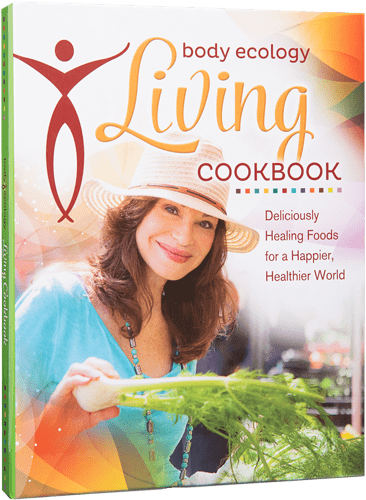The complete Body Ecology guide to organizing your kitchen for efficient and healthy cooking
The right tips for menu planning and learning to organize your kitchen make getting healthy so much easier. When beginning your Body Ecology program, the kitchen is your place to start. Think of it as command central for your vibrant, new life and healthy body.
 Our goal has always been to change the way the world eats. By doing so, we help create a happier, healthier world. If you don’t know where to begin, The Body Ecology Living Cookbook, full of fresh and flavorful recipes, is a must in any healthy cook’s kitchen.
Our goal has always been to change the way the world eats. By doing so, we help create a happier, healthier world. If you don’t know where to begin, The Body Ecology Living Cookbook, full of fresh and flavorful recipes, is a must in any healthy cook’s kitchen.Organizing Your Kitchen: Why It Matters (A Lot)
You might have heard it said that the kitchen is the most important room in the house, and I’m inclined to agree.1 Not only is it the most used room, but it’s where people gather to cook, connect, and eat after a busy day and hectic week.
My first priority in the kitchen is always cooking with love. It may not seem possible if you are used to rushing through your recipes or eating out, but preparing your food with a heart of gratitude can actually change how your food tastes — and how it may nourish your body.
My time spent in the kitchen is so special. I primarily cook and prepare food to use food as medicine, to support healing in the body. But I also prepare meals for my friends and family with a heart of gratitude and with love. Preparing food with love means that your food “feels” your energy and responds in a loving way back to you. Now “food as medicine” makes perfect sense.
Getting your kitchen in order allows you to better prepare each meal with a heart of love and a healthful mindset. And it has research-backed benefits too. The Cornell Food & Brand Lab observed in 2016 that while chaotic and cluttered environments can increase stress and encourage overeating, a clean and organized kitchen could help to reduce mindless snacking.2
You can make your kitchen a healthy, organized, and meditative space with my best-practice guidelines below.
Want to learn more about me? Here is where my healing journey began.
Step #1: Food Choices
First look at the foods you already have, then decide which ones you would like to try.
You might already eat leafy greens, garlic, and onions, so how about adding Body Ecology staples like:
- Amaranth
- Buckwheat
- Millet
- Quinoa
- Apple cider vinegar
- Fermented foods and drinks
- Green tea (loose leaf, bags, or powder)
- Organic, unrefined oils
- Red-skin potatoes
Some foods that were once difficult to find have now become more available if you seek special sources for them. These foods include:
- Cage-free eggs
- Free-range poultry
- Grass-fed beef
- Konjaku noodles
- Ocean vegetables
- Organic, gluten-free, unrefined coconut oil
- Quinoa flakes
- Wild salmon
- Celtic sea salt
Get regular updates on the latest happenings in the Body Ecology Kitchen: Sign up for our newsletter.
All of these foods and the delicious recipes in The Body Ecology Diet have been tested in our Body Ecology test kitchens. Over the years, we’ve found convenient, high-quality online suppliers and will continue to add to this list. Today, you can now obtain everything you want and need in our Body Ecology System of Health and Healing.
Once you’ve decided what kinds of food you enjoy or would like to try, it’s time to think about menus — before you head to the grocery store.
Step #2: Menu Planning
Making a menu can be the best way to plan your new Body Ecology lifestyle. Have fun as you plan. Think of the recipes you’d love to try, and be creative! Once you’ve created a plan, then you just have to follow it. Menus also simplify shopping and preparation, leaving you with more time to enjoy your food and your life.
When I wrote The Body Ecology Diet, I wanted to make sure you would have plenty of ideas for main dishes, salads, dressings, desserts, and snacks! Snack ideas are actually included throughout The Body Ecology Diet book because I found that carrying healthy snacks during my day allowed me to resist the temptation for processed foods while I was out. I even included sample menus to make it easier to figure out where to begin.
Once you have your menu plan, make your shopping list and decide how often you want to shop. It could be once per week or more often, if you have the time.
The most important thing is to balance your life, and it’s no different with Body Ecology. Decide what works for you based on the time you have.
Perhaps shopping online will make things even easier. It has certainly helped in my life. Try our favorite Internet suppliers, your local supermarkets, and health food stores. Seek out fresh produce and herbs at farmers’ markets.
We have a big collection of Body Ecology recipes that make menu planning a breeze.
Step #3: Food Storage
Once you have all your healthy Body Ecology foods, create a kitchen system that makes sense for you. Sometimes, organizing your kitchen tools is all it takes for more efficient cooking.
Here are some ideas for organizing your kitchen:
- Keep garlic and onions near your cutting board and a sharp knife.
- In your refrigerator, try one shelf for leftovers and another for fresh foods.
- If you live with people who are not following Body Ecology, keep their food in a separate cupboard or on a different shelf in your refrigerator.
- Get plenty of glass storage dishes, like Pyrex containers with plastic lids, because they are safer than plastic containers for storing and reheating food.
Step #4: Kitchen Equipment
You probably already have some good kitchen equipment, but over the years, we’ve found these to be a big help to your Body Ecology lifestyle:
- Ball Jars: I love these glass jars, specifically the wide-mouth quart size. I use them to make fermented foods and drinks.
- Blender: This powerful blender can make delicious juices that retain all of their healthy fiber, giving you a complete meal that is easily digested and won’t increase your blood sugar. The highly rated Vita-Mix is definitely my pick for making your own fiber-rich drinks and creamy soups. Use it to make our Good Morning Greens smoothie for breakfast!
- Cookware: Le Creuset makes beautiful and functional pots and pans to cook all kinds of foods. You never have to worry about the enamel and cast iron materials reacting with your foods or depositing unwanted toxins.
- Fine Wire Mesh Strainers make life easier, whether you are making Young Coconut Kefir, draining soaked grain-like seeds, or draining your soaked almonds.
- Food Dehydrator: Food dehydrators dry out your soaked nuts and seeds at low temperatures, are great for making raw food snacks, and can even be used to make cookies sweetened with Stevia.
- Food Processor: Food processors like the Cuisinart 7 Cup Classic or 14 Cup Stainless Steel models are indispensable for making cultured vegetables at home. They also make salad preparation simple and can be used to put together a delicious nut or vegetable plate.
- Pressure Cooker: You can use a pressure cooker to make your Body Ecology grain-like seeds in half the time.
- Shredder: Our absolute favorite appliance for making large amounts of cultured veggies quickly is the Veggie Bullet. It delivers professional results with ease and flies through vegetable chopping. The Veggie Bullet offers 3-in-1 functionality as a slicer, shredder, and spiralizer. To learn how to make cultured vegetables quick and easy, you can watch Part 1 of my Veggie Bullet Tutorial right here.
- Slow Cooker: A slow cooker (also called a crock pot) is an easy way to fix a meal and forget about it. It’s ready when you are. Plus, the new ones have timers for precise cooking, and they’re ideal for Body Ecology soups.
- Stainless Steel Wide Mouth Funnel: Use your wide-mouth funnel to put homemade fermented foods and drinks into jars. It makes the process super-simple!
Take It Step-by-Step (And Give Yourself Some Credit)
Having raised children while running a growing business and traveling often, I understand the challenges of eating healthy foods.
I want to acknowledge you for the work you are doing to keep yourself and your family healthy. It means taking extra time to learn where to find and how to prepare truly nourishing foods that heal. It means going the extra mile to seek foods with the best ingredients and to prepare foods instead of heating them up in a microwave or grabbing a quick bite in fast food restaurants.
But more than anything else, you are creating a legacy of health for generations to come.
Always remember the Principle of Step-by-Step. Be a turtle. Slow and steady — not a hare — and become a winner in creating balance, vibrancy, and longevity. And when selecting kitchen tools and organizing your kitchen, incorporate new foods and cooking techniques as you are ready. You’ll soon be able to manage and maintain your lifestyle changes and wholly benefit from Body Ecology’s System for Health and Healing. Bon appetit!
What To Remember Most About This Article:
Cooking with love and a heart of gratitude is one of the best ways to use your food as medicine.
You can take control of your kitchen — and your health — by following four simple organizing guidelines that I practice in my own life:
- Step 1: Reassess your food choices and add in some Body Ecology staples, like millet, quinoa, buckwheat, red-skin potatoes, cage-free eggs, free-range poultry, apple cider vinegar, green tea bags or powder, Celtic sea salt, and fermented foods and drinks.
- Step 2: Plan your weekly menu, and have fun with it. You can get healthy snack ideas and sample menus from our Body Ecology Diet book. The new Body Ecology Living Cookbook also has plenty of healthy and delicious recipes to get you started.
- Step 3: Use food storage solutions to organize your kitchen for more efficient cooking. I recommend keeping basics, like garlic and onions, near your cutting board to make healthy cooking a natural reflex. Also, try designating one shelf in your refrigerator for leftovers and another for fresh foods.
- Step 4: You can find my full list of recommended kitchen equipment above. Including even a few of these appliances in your kitchen can make fresh and nutritious cooking a lot easier. You can use a wire-mesh strainer when making Young Coconut Kefir or a food dehydrator to prepare cookies sweetened with Stevia. I swear by the Veggie Bullet to whip up cultured vegetables.
When all is said and done, give yourself a little credit for the progress you have made and remember to take it slow. Step-by-step, you’ll get your kitchen in order and begin to change the way you and your family eat.
REFERENCES:
- Grant, Carolyn Muse. “Kitchen is the most used room in the house.” Las Vegas Review- Journal.
- L. R. Vartanian, K. M. Kernan, B. Wansink. Clutter, Chaos, and Overconsumption: The Role of Mind-Set in Stressful and Chaotic Food Environments. Environment and Behavior, 2016; DOI: 10.1177/0013916516628178.








